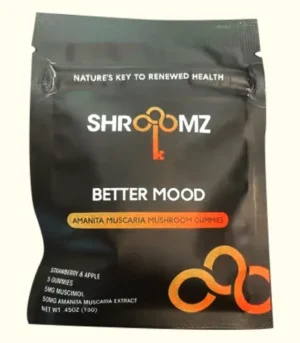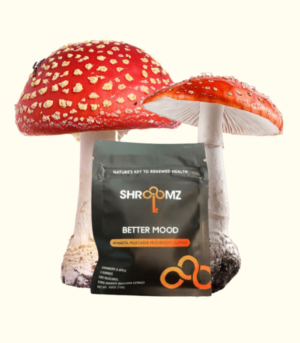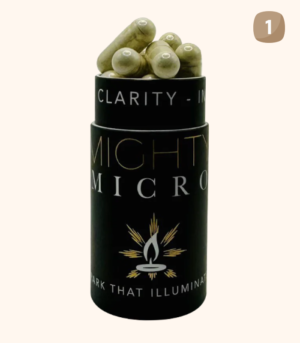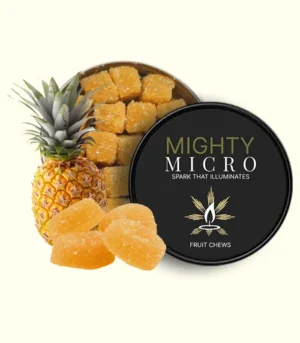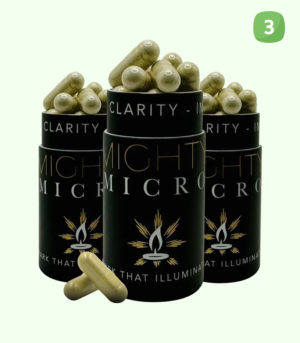Amanita Muscaria
Here is a collection of the best Amanita Shroomz Gummies that you can order online. Add your favorite fly amanita mushrooms from the given items to your cart and complete your order successfully.
Showing the single result
Showing the single result
What Is Amanita Muscaria?
Amanita Muscaria, also known as the fly agaric, is a brightly colored mushroom with a red cap and white spots. This iconic fungus is renowned for its psychoactive properties due to compounds like muscimol and ibotenic acid. Historically, it has been used in shamanic rituals and folklore. While visually striking, it is toxic and can cause severe symptoms if ingested.
How do you choose the best amanita muscaria gummies?
To choose the best Amanita Muscaria gummies, consider factors like ingredient quality, dosage, and third-party testing. Look for products made with natural ingredients, clear labeling of muscimol content, and certification for purity and safety. Reading customer reviews and checking for reputable brands can also guide your decision. You can also find the best Amanita muscaria mushroom gummies at The Magic Mushroom Shop.
What are the Benefits of Amanita Muscaria Mushrooms?
Amanita Muscaria, renowned for its bright red cap with white spots, has captivated the interest of many cultures throughout history. While often associated with toxicity, Amanita Muscaria also offers potential benefits when used correctly.
-
Psychoactive Properties of Fly Agaric
According to a study published in the journal Psychopharmacology, Amanita Muscaria contains psychoactive compounds such as muscimol and ibotenic acid. These compounds interact with neurotransmitter systems in the brain, leading to altered states of consciousness. Users report experiencing euphoria, visual and auditory hallucinations, and a sense of detachment from reality. These effects have made Amanita Muscaria a staple in shamanic rituals and spiritual practices across various cultures.
-
Therapeutic Uses
Historically, Amanita Muscaria has been used in traditional medicine to treat ailments such as pain, fatigue, and anxiety. Modern research is exploring its potential therapeutic applications. For example, muscimol’s interaction with GABA receptors in the brain suggests it could be beneficial in managing conditions like epilepsy and anxiety disorders. A study by Pharmacology Biochemistry and Behavior indicated that muscimol might have anxiolytic effects, providing a potential alternative for anxiety treatment.
-
Potential Neuroprotective Effects
Preliminary research suggests that the compounds in Amanita Muscaria may have neuroprotective properties. A study published in the journal Neurochemistry International found that muscimol could protect neurons from oxidative stress and excitotoxicity, which are key factors in neurodegenerative diseases. This finding points to the potential of Amanita Muscaria in treating conditions such as Alzheimer’s and Parkinson’s diseases.
-
Antimicrobial Properties
Research published in the Journal of Ethnopharmacology highlights the antimicrobial properties of Amanita Muscaria extracts. These properties could be harnessed to develop new treatments for bacterial and fungal infections. The study identified several bioactive compounds in Amanita Muscaria that exhibited inhibitory effects against common pathogens, indicating its potential as a natural antimicrobial agent.
-
Cultural and Historical Significance
Amanita Muscaria holds a prominent place in the folklore and traditions of many cultures. In Siberian shamanism, for example, it has been used for centuries in rituals aimed at inducing trance states and facilitating communication with the spirit world. This cultural significance underscores the mushroom’s role in promoting mental and spiritual well-being, as documented in The Sacred Mushroom and the Cross by John M. Allegro.
-
Potential Mood Enhancement
According to anecdotal reports and historical records, Amanita Muscaria has been used to enhance mood and alleviate stress. Users have reported feelings of relaxation and reduced anxiety after consuming the mushroom. This effect is likely due to muscimol’s interaction with GABA receptors, which play a crucial role in regulating mood and anxiety levels.
What are the uses of fly amanita muscaria?
Fly Amanita has been traditionally utilized for medicinal purposes, offering potential health benefits. Additionally, it is popular in recreational settings due to its psychoactive properties. Culturally, Fly Amanita has been significant in practices such as Siberian Shamanism and the Viking Berserkers. These diverse applications make it a unique and valuable mushroom.
Below, we explore the various medicinal and recreational uses of Fly Agaric in detail.
Medicinal Uses of Amanita Muscaria
- Antiseptic Properties: Traditionally, Amanita muscaria has been used as a topical antiseptic for minor wounds and skin infections. According to Hobbs (1995), the mushroom’s compounds were believed to possess antibacterial effects, making it a valuable resource in folk medicine.
- Sedative Effects: In small doses, Amanita muscaria has been used as a sedative. Its psychoactive compounds, when carefully administered, can promote relaxation and sleep. Stamets (2005) explains that these effects are due to the presence of muscimol, which interacts with the central nervous system. Historically, it was used by some cultures to ease anxiety and induce sleep, especially in patients with insomnia.
Recreational Uses of Amanita Muscaria
- Entheogen: Amanita muscaria is consumed for its hallucinogenic and psychoactive effects. The primary psychoactive compounds, ibotenic acid and muscimol, can induce vivid hallucinations and altered perceptions of reality. Proper preparation is crucial to mitigate its toxicity. According to Ott (1993), this involves drying the mushroom to convert ibotenic acid into the less toxic muscimol. Users often describe their experiences as dreamlike and surreal, which has contributed to its use in various spiritual and recreational contexts.
Insect Repellent:
- Fly Trap: Historically, Amanita muscaria was used to attract and kill flies. Benedict (1986) notes that the mushroom was crushed and mixed with milk, creating a solution that attracted flies, which then died after consuming it. This practice gave the mushroom its common name, “fly agaric.” This method was commonly used in rural households to control fly populations, leveraging the natural insecticidal properties of the mushroom.
Are amanita muscaria gummies are safe?
Fly Amanita mushroom, can be safe when used responsibly and in moderation. However, it is important to note that these gummies contain psychoactive substances, making proper dosage and understanding of individual tolerance crucial. Consumers should always follow guidelines, consult healthcare professionals if unsure about the appropriate usage, and check local regulations before us.
Is Amanita Muscaria Legal In The US?
Amanita muscaria is not classified as a controlled substance under federal law in the United States, making it legal in most states. However, it is important to note that Louisiana has included Amanita muscaria and its primary compound, muscimol, in its list of prohibited hallucinogenic substances. This means that in Louisiana, possessing or using Amanita muscaria is illegal.
What makes up Amanita muscaria?
Amanita muscaria, commonly known as fly agaric, contains three primary psychoactive compounds: muscimol, ibotenic acid, and muscazone. Muscimol, derived from ibotenic acid through decarboxylation, acts as a GABA-A receptor agonist and has sedative effects. Ibotenic acid, similar to the neurotransmitter glutamate, has neurotoxic effects. Approximately 100 grams of dried Amanita muscaria contains about 180 mg of these compounds.
What Are the Psychoactive Compounds in Amanita Muscaria?
Amanita muscaria contains three primary psychoactive compounds:
- Muscimol: Acts as a potent agonist of GABA-A receptors, causing sedative and hallucinogenic effects.
- Ibotenic Acid: Converts to muscimol through decarboxylation and has neurotoxic effects similar to the neurotransmitter glutamate.
- Muscazone: Another psychoactive compound found in smaller amounts.
These compounds are responsible for the mushroom’s psychoactive and toxic properties.
What Are the Cultural Significances of Amanita Muscaria?
Amanita muscaria, the fly agaric mushroom, holds significant cultural importance across various societies. In northern Europe and Siberia, it has been used in shamanic rituals for centuries to induce altered states of consciousness and facilitate communication with spirits.
Some researchers believe it may be the Soma mentioned in ancient Vedic texts and link it to the “tree of life” in various religious rites and mythologies. The mushroom frequently appears in European folklore and fairy tales, often associated with mystical creatures like fairies and gnomes.
Amanita muscaria is connected to Christmas traditions, with its red and white colors possibly inspiring the modern depiction of Santa Claus and stories of flying reindeer. In modern popular culture, it is featured in literature, art, and video games, symbolizing fantasy and altered realities.
Conclusion
Amanita Muscaria, commonly known as the fly agaric, is a visually striking mushroom with red caps and white spots, renowned for its psychoactive properties due to compounds like muscimol and ibotenic acid.
Historically used in shamanic rituals, it offers various benefits, including potential therapeutic and neuroprotective effects, antimicrobial properties, and mood enhancement. Though toxic, responsible usage of products like Amanita Muscaria gummies can provide psychoactive experiences, therapeutic applications, and historical medicinal uses. Legal in most U.S. states except Louisiana, Amanita Muscaria holds significant cultural and historical importance, enriching traditions, folklore, and modern pop culture.
FAQs About Amanita Muscaria Mushrooms
Is It Possible to Overdose on Amanita Shroom Gummies?
Yes, it is possible to overdose on Amanita shroom gummies. Amanita mushrooms contain toxic compounds that can cause serious health issues if consumed in large quantities. Always use caution and follow dosage guidelines.
How Long Do the Effects of Amanita Shroom Gummies Last?
The effects of Amanita shroom gummies typically last between 6 to 8 hours. Duration can vary based on dosage and individual factors. Always start with a small amount to gauge your response.
Can Amanita Shroom Gummies Interact With Other Medications?
Yes, Amanita shroom gummies can interact with other medications. Consult a healthcare professional before combining them with any prescription drugs.
Do mushroom gummies help you sleep?
Yes, certain mushroom gummies can help you sleep, particularly those containing compounds known for their sedative effects. For instance, Amanita Muscaria gummies contain muscimol, which interacts with GABA receptors in the brain, promoting relaxation and sleep.
Are Amanita Muscaria are Worth of money?
Amanita Muscaria can be valuable for their unique psychoactive effects and traditional uses, but their safety and legality vary. Evaluate your priorities and risks before purchasing.
What are the effects of Amanita mushroom gummies?
Amanita mushroom gummies can cause sedation, hallucinations, and altered perceptions. They may also induce euphoria and muscle relaxation. Always use with caution due to potential toxicity.
What happens if you eat raw wild Amanita caesarea mushrooms?
Eating raw wild Amanita caesarea mushrooms is generally safe as they are considered edible and delicious. However, always ensure correct identification to avoid confusion with toxic Amanita species.
Do mushroom gummies give you energy?
Certain mushroom gummies, like those containing Cordyceps, can boost energy and enhance endurance. The effects depend on the specific type of mushroom used.

